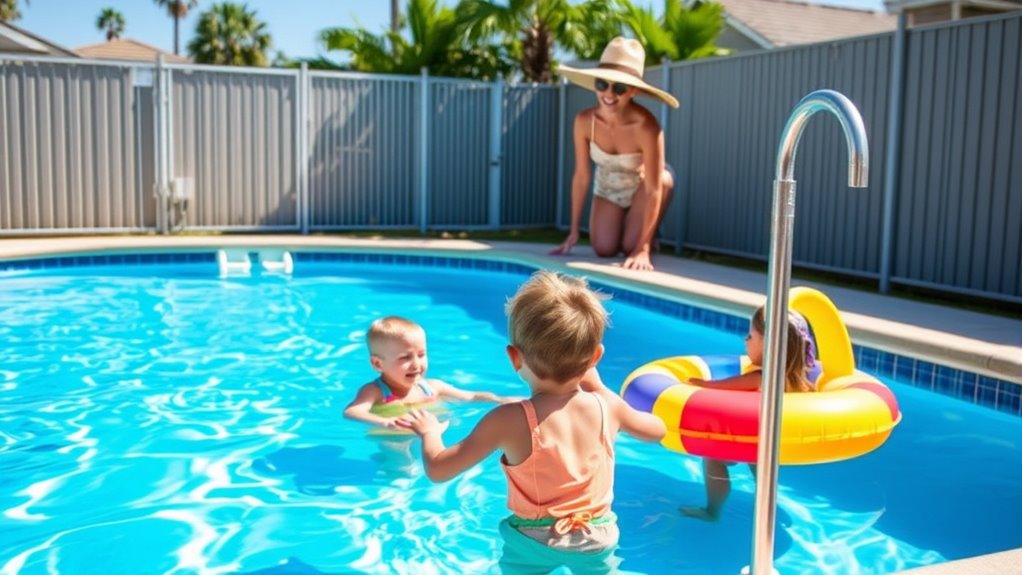To protect kids by the pool, it’s essential to combine multiple safety measures. Install a sturdy, self-closing fence around the pool and ensure gates are locked when not in use. Enroll children in swim lessons to build water skills and confidence, and always supervise them closely. Use life jackets for inexperienced swimmers and remove toys from the area when not in use. Following these layered safety practices can vastly reduce risks—keep exploring to learn more ways to keep kids safe.
Key Takeaways
- Install secure, self-latching fencing at least four feet high around the pool to prevent unsupervised access.
- Provide swim lessons to teach children water safety skills and increase their confidence in the water.
- Never leave children unattended near the pool, and always supervise them closely during water activities.
- Use life jackets for inexperienced swimmers and remove toys from the pool when not in use to prevent accidents.
- Implement layered safety measures, including fencing, supervision, and safety equipment, for comprehensive pool safety.

Have you ever wondered how to keep your kids safe around the pool? It’s a natural concern, especially since drowning remains a leading cause of injury for young children. The good news is that implementing simple, effective safety measures can drastically reduce the risk. One of the most important steps is enrolling your kids in swim lessons. These lessons teach children essential skills, such as floating, treading water, and basic strokes, giving them the confidence and ability to handle themselves in the water. Swim lessons not only build their swimming skills but also help them understand water safety rules, making them less likely to panic or make risky decisions when they’re in or near the pool.
Enrolling kids in swim lessons teaches essential skills and safety rules, reducing drowning risks and building confidence around water.
Alongside swim lessons, fencing barriers serve as a physical safeguard that adds an extra layer of protection. A sturdy, self-closing, and self-latching fence around the pool creates a secure boundary that prevents kids from accessing the water unsupervised. When you install fencing barriers that are at least four feet high, it becomes much harder for young children to climb over or slip through. Make sure the fencing has no gaps or openings where little fingers can get caught or squeezed. Keep gates locked when the pool isn’t in use, and regularly check the fence for any wear or damage. This barrier acts as a critical line of defense, especially when adult supervision isn’t immediately available.
Combining swim lessons with fencing barriers offers a thorough approach to pool safety. While swim lessons provide children with the skills to stay safe in the water, fencing barriers physically prevent accidental access. These measures work best when supported by constant supervision. Never assume that your child’s swimming ability means they’re safe to be alone near the pool. Always watch children closely, and designate a responsible adult to supervise at all times. It’s also wise to establish clear rules, such as no running or diving in shallow areas, and teach your children to respect the pool boundaries.
In addition to fencing and lessons, other safety practices like using life jackets for less experienced swimmers and removing toys from the pool area when not in use can minimize hazards. Remember, safety around the pool isn’t just about one measure; it’s about creating a layered approach that keeps your children protected from every angle. By investing in swim lessons, installing fencing barriers, and maintaining vigilant supervision, you substantially lower the chances of accidents and help your kids enjoy the pool safely. Being aware of cybersecurity vulnerabilities that can occur during emergencies emphasizes the importance of safeguarding your family’s safety both online and offline.
Frequently Asked Questions
What Are the Signs of Drowning in Children?
You should watch for signs of drowning like a child struggling to breathe, silent sinking, or sudden loss of movement. Keep supervision strategies in mind, staying close and attentive at all times. If you notice these signs, act quickly with water rescue techniques—reach, throw, or go if necessary. Remember, staying alert and prepared can prevent tragedies and help you respond effectively during emergencies.
How Often Should Pool Safety Equipment Be Checked?
Checking pool safety equipment is like tuning a musical instrument—regularly and carefully. You should perform safety inspections at least once a month and after any big weather event. During pool maintenance, verify all safety devices, such as life hooks, alarms, and fences, are in working order. Promptly replace or repair damaged items to keep your pool safe. Consistent checks help prevent accidents and keep your kids protected.
Are Pool Alarms Effective for Child Safety?
Pool alarms are generally effective for child safety, but their reliability depends on the model and installation. You should choose alarms with proven pool alarm reliability and integrate them as part of your overall child safety technology. Regularly test and maintain the alarms to make certain they function properly. When used correctly, pool alarms can alert you promptly, helping prevent accidents and keeping your kids safe around the water.
What Should I Do if a Child Ingests Pool Water?
If a child ingests pool water, stay calm and act quickly. Call poison control immediately and follow their guidance. While waiting, supervise the child closely and monitor for symptoms like nausea, vomiting, or difficulty breathing. Make certain pool chemical safety by keeping chemicals out of reach. Remember, constant supervision is your best defense—stay vigilant, and act swiftly to protect your child’s health and safety.
How Can I Teach Kids Water Safety at a Young Age?
To teach kids water safety early, you should emphasize constant child supervision and make lessons engaging. Use water safety toys to help them learn water awareness and buoyancy skills in a fun way. Consistently reinforce safety rules, like never swimming alone, and practice emergency responses together. By actively engaging with your kids and using supportive tools, you help them develop confidence and good habits around water from a young age.
Conclusion
So, next time you’re at the pool, remember: watch your kids like a hawk, because drowning is apparently the latest trend nobody wants to join. Keep those floaties handy, and don’t let them play Houdini with pool gates. After all, it’s way more fun to be the hero than to have to explain why you turned your backyard into a splash zone of regret. Safety first—because poolside disasters aren’t exactly a summer blockbuster you want to star in.









